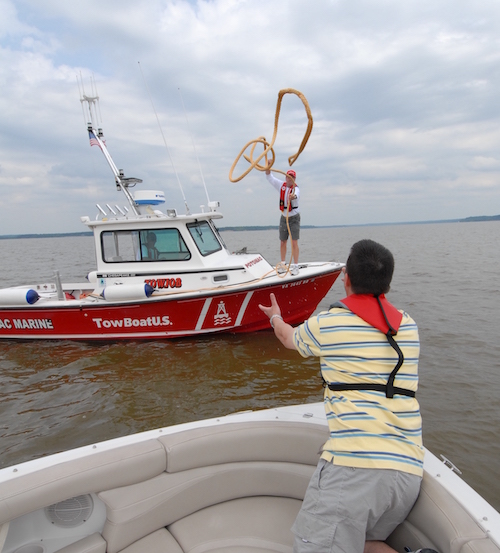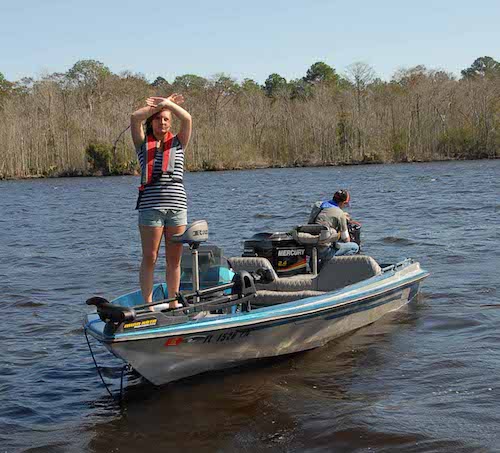Disclaimer: Here at Discover Boating, we strongly advise against recreational boaters engaging in the process of towing another boat on the water. Recreational boats do not carry the right equipment and are not properly rigged for towing. We do, however, encourage boaters to stop and assist other boaters to make sure they are safe and to help them get assistance. Rendering assistance as a Good Samaritan means helping the people, not the boat.
Towing a disabled boat can be dangerous, and should only be completed by trained professionals, such as the US Coast Guard, authorized local authorities, or a specialized on-water assistance organizations like Sea Tow or TowBoatUS.
Not every day on the water goes as planned, and an empty fuel tank, a dead battery or a mechanical issue can leave a boat and its crew dead in the water. It’s a maritime tradition to render assistance to those in danger at sea. If your buddy’s boat breaks down, they may not be in danger, but they are likely in need of a tow back to dock or launch ramp.
Here are some things to consider before towing a boat in the water.
Boat Towing Coverage & Memberships 101: What You Need to Know
7 Steps for Towing a Boat in the Water
If there is absolutely no other alternative and you feel confident that you can safety tow the disabled boat a short distance with your vessel, follow these tips:
- Rig up a bridle to spread the strain of towing to two points on your boat using two dock lines.
- Always approach the disabled boat into any wind or current to prevent drifting.
- Once the tow line is secured, take the slack very slowly and then accelerate gradually.
- While towing: go slow, never put your boat in reverse, and plan to make wide turns.
- Tow the disabled boat to the nearest safe harbor or dock.
- Make your final approach to the dock or ramp into prevailing wind or current.
- Slowly approach the dock, secure your boat, then use the tow line to pull the disabled boat to the dock by hand.
Be sure to communicate that, as the captain of the towing vessel, you will be command of the operation.
As you rig up the bridle with two dock lines:
- Pass the bitter end of each dock line (the end without a spliced loop) through a transom eye of your boat and then to the stern cleat on that side of the boat.
- A long anchor line—ideally at least 100 feet in length and already on the other boat—can be used for the tow line.
- Remove the anchor and secure the line to a bow cleat, then through the bow eye so that the pulling force is on the center of the disabled boat.
- Next pass the other end of the tow line through both loops on the end of your bridle, and tie the line with a bowline knot.
Once the tow line is secure and you begin towing, remember that you should never put your own boat in reverse. This could allow the tow line or bridle to snag on your prop. Also keep in mind that you are not going to be able to get on plane. Plan to tow the boat to the nearest safe harbor or dock, even if that’s not the ramp or marina where the disabled boat started out.
When rounding bends or navigating around markers or docks, be conscious of the fact that towed boat is going to turn inside the towing boat (on a tighter radius).
Identifying a Disabled Boat that Needs a Tow
The basic signal from a boat in distress is waving both hands over the head, which should cause you to investigate by carefully approaching the boat making the signal.
- Don’t get too close—if the other boat has run aground or suffered damage from striking an object under the water you don’t want to suffer the same fate, and put two boats in distress.
- Find out what’s wrong with the other boat, if that captain knows.
- Consider the weather, wind, tide or current, and your own boat-handling skills. Do you feel you can approach the other boat safely? If not, the best course of action is to call or radio for professional assistance from a towing outfit (SeaTow or TowBoatUS, for example), local law enforcement, or the U.S. Coast Guard.
- Also consider the condition of the captain and crew of the other boat. If they appear to be intoxicated or angry, for example, they probably will not be good partners in a towing effort and if no individual is in danger, you should render assistance by contacting professional help or law enforcement.
Alternatives to Towing
Towing another boat can be tricky, and is best accomplished when the boat doing the towing is the same size or larger than the disabled boat. Your 17-foot bowrider is not a good candidate for towing a 30-foot cruiser. In this case, you could offer to approach and transport the crew to shore, leaving the disabled boat at anchor until professional help can step in. This of course assumes you can safely board the crew, and will not over-load your boat.
Before engaging in a tow, see if there’s an easier way to help. If the disabled boat has simply run out of gas, for example, offer to run to the marina and return with a jug of fuel.
It’s never a good idea to try and pull free a boat that has run aground, a situation best handled by a pro with the right heavy-duty equipment, or simply waiting for the tide to float the grounded boat free.
Towing a disabled boat is going to take a lot of time and fuel. Ask yourself:
- Is there enough daylight to make it to a marina, dock or ramp at a speed of 5 MPH?
- Does your boat have enough fuel to make the tow? You’ll be burning much more fuel than normal even at this slow speed.
If you don’t have time or fuel to complete the tow, don’t start.
Your Obligation as a Fellow Boater
Federal law (Federal Code 46-2304) stipulates that “the master or person in charge of a vessel is obliged to assist others in danger unless rendering such assistance would place his/her own vessel, crew or passengers in serious danger.” The duty does not extend to saving property (such as another boat), but to saving “any individual found at sea in danger of being lost.”
Federal statutes contain a specific “Good Samaritan” provision which provides that those who render assistance shall not be found liable for the damage caused by their efforts unless they have failed to exercise reasonable care.
If you do find yourself in a situation where you may have to tow another boat at sea, remember that safety should always be your number one concern. Once you do complete a successful towing mission, let good boating karma be your reward. Taking any payment or remuneration for your deed will negate the Good Samaritan provision of the law.
Read Next: 12 Common Boating Mistakes & How to Avoid Them
You May Also Like:

